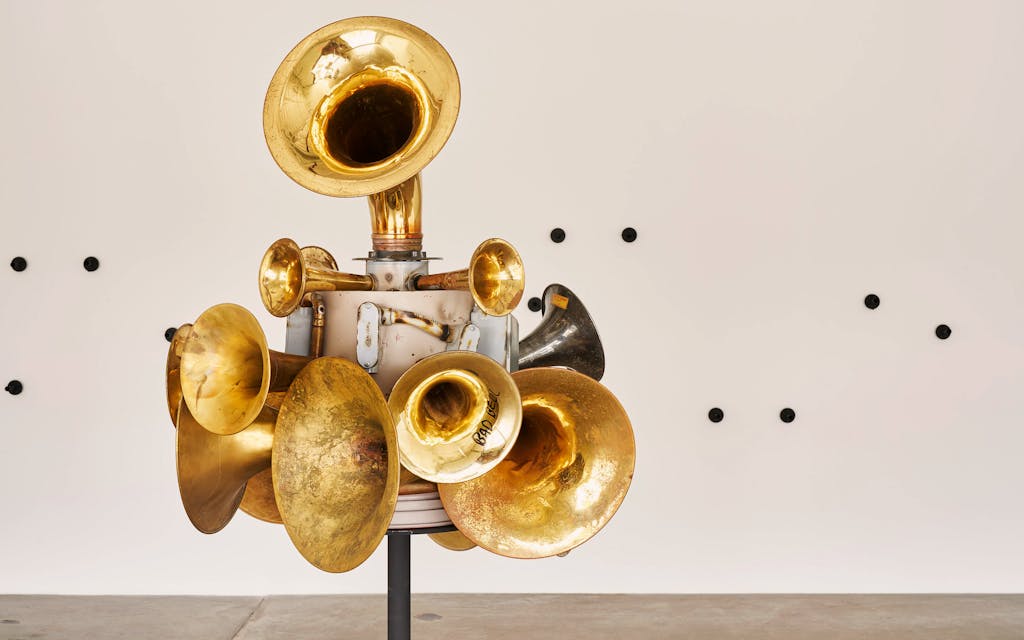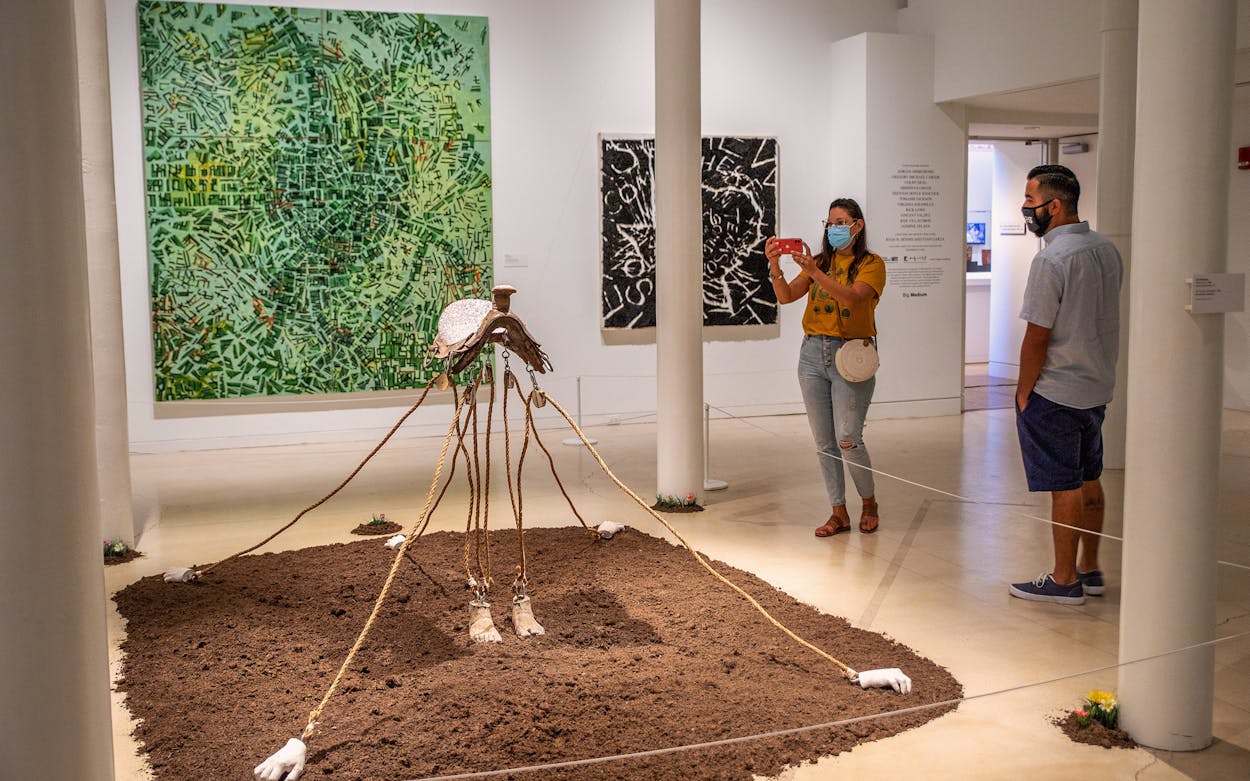It’s an exercise in oversimplification to pick out just one piece of art to represent an omnivore’s banquet of an art show like the 2021 Texas Biennial, a celebration of the best Texas art of the past few years open now through January 31 at five venues in San Antonio and Houston. Texas is a big, diverse place with all stripes of geniuses and troublemakers inhabiting its borders. Different visitors to the biennial exhibitions will be moved by different currents among the 51 artists on display. But for me, the key to the entire show is a small, unassuming work by an artist I’d never seen before, Houston’s Phillip Pyle II.
Pyle’s Broken Obelisk Elbows is a satirical proposal for a public art intervention. It takes on one of the most iconic artworks in Texas, Barnett Newman’s Broken Obelisk (c. 1967), which has lived for decades just outside the Rothko Chapel in the Montrose neighborhood of Houston. Newman’s three-ton steel sculpture is abstract but heavy with meaning—it is dedicated to Martin Luther King Jr., who was murdered after it was completed. It attracted controversy in its time in part because it was seen as suggesting a severed and overturned Washington Monument, and in part because the City of Houston refused to receive it as a gift in 1969 because it was on the condition that the city officially dedicate it to King.
Pyle’s hilarious proposal is to “trick out” Newman’s highbrow Abstract Expressionist masterpiece with low-rider flair. He’s added a pair of protruding gold spoke wire rims, emblems of Texas urban car culture. Newman was white and Pyle is Black, which gives the tune-up the sense of a historical correction—an ironic, satirical commentary on who gets to do public monuments, especially those dedicated to non-white leaders. Pyle toys with genteel audiences’ worst nightmares of what a Black artist would do with such a memorial, inverting Newman’s rusting, enigmatic testimony to speak brashly to our present moment of upheaval and possibility.
If this edition of the biennial, titled “A New Landscape/A Possible Horizon,” is telling us one thing, it’s that Texas is ready for new monuments. It should be noted that the exhibition doesn’t claim to present an argument or thesis—that would be curatorial overreach for a survey show that seeks to reflect the diverse interests of artists across the state—but a theme emerges nonetheless through the preoccupations of the artists on display. The problem of public memory, of how we use art and monuments to teach and learn about our fraught history, has been much-discussed in the three-plus years since the last installment of the Texas Biennial. Add to that the need to gestate and memorialize the traumas of the pandemic, which caused this biennial to be delayed by over a year, and you could say that Texas artists have a lot to get off their chests. Featuring simultaneous exhibitions at the San Antonio Museum of Art (SAMA), McNay Art Museum, Artpace, and Ruby City in San Antonio (as well as a photography-focused show at FotoFest in Houston), the 2021 biennial feels like a vision of the monuments our present moment deserves.
Pyle’s work is almost immaterial, just the wisp of a clever idea on paper. Other biennial works are far more substantial. Also at the McNay, occupying part of the outdoor sculpture garden, is Piers, West disrupted, a piece by Jarrod Beck, who lives part-time in Terlingua. Beck’s sculpture is a collection of fire-scarred “totems”—pillars made from iron ore poured into wooden molds, which he then burned off. Beck says the sculpture is inspired by seeing groups of people lining up for COVID tests and vaccines. This rings true. The charred metal forms seem harried, traumatized, but also raw with undischarged energy. They work both as abstract forms and as narrative-laden characters.

Beck’s work is in conversation with Pyle’s—one totemic vision to another. The 2021 biennial is rich with such confluences of symbolic material across artworks lovingly arranged by curators Ryan N. Dennis and Evan Garza. Probably the most impressive room of the show is upstairs at SAMA, where recent wall hangings by some of the biggest names in Texas art, including Rick Lowe, Trenton Doyle Hancock, Virginia Jaramillo, and Vincent Valdez, surround a central installation by relative newcomer Jose Villalobos. I liked the way Valdez’s work, a series of sketches featuring impressions, dreams, and messages from a trip to the militarized South Texas border, plays off of the installation by Villalobos, one of the only border-area artists on display in the biennial. Valdez’s work is documentary, expertly depictive even when segueing into fantasy. Villalobos, whose sculptures often employ macho norteño cowboy gear to tell stories of his life growing up gay in El Paso, takes a more allegorical approach. He uses Texas clichés—rope, saddle, a field of dirt—and adds glitter, pulleys, flowers, and five outstretched hands reaching for them. The outcome is, for me at least, a monument to the idea of fumbling through and beyond the symbolic world you’re born into while in the process of becoming yourself.
Villalobos will conduct a live performance art piece at SAMA on October 12. Likewise, Austin-based Steve Parker will be activating a sound-art performance outdoors at McNay on November 7–10. In the meantime, Parker also has a sculpture up at the McNay. Titled Sirens, it’s a bouquet of brass horns, reminiscent of old-fashioned gramophones, playing sad vocal dirges in multiple languages, evoking the global scale of the pandemic’s toll. Memories of those disorienting early weeks hearing ambulance sirens in the distance are unavoidable.
This edition of the Texas Biennial is unique for including so-called Texpats, or artists with Texas roots who no longer live here, as well as a few artists who have never lived in Texas but make art specifically about the state. It’s a controversial decision, because it theoretically means fewer slots for Texas-based artists. But it’s hard to argue with trying it just this once, especially in a pandemic year. It’s another step in the ongoing efforts by biennial organizer Big Medium, an Austin-based nonprofit, to push beyond its historical comfort zone on the gentrified East Side of its hometown to seek out new partners and diverse voices further afield.

The decision to allow Texpats has yielded a striking sculptural installation for the Ruby City space by Sondra Perry, a New Jersey–based artist who grew up in North Texas. Perry’s piece incorporates an enormous iron crucible, shackles from the era of American chattel slavery, other archaic metal materials, and video monitors showing a molten fire. Titled you out here look n like you don’t belong to nobody: heavy metal and reflective, it’s a meditation on the historical relationship between material and power in America. It’s also across the room from work by famed Houston-born artist Melvin Edwards, who in his long career outside the state has explored similar themes more compactly, welding together found metal tools and objects into dense, sculptural wall hangings. Several other artworks touching on race, violence, and politics fill out the Ruby City space, including three large conical hanging canvases by Houston’s Mich Stevenson that suggest Ku Klux Klan heads. The room as a whole is an eerie, haunted monument, evoking emotional truths from a history of violence that is not fully past.
Not all of the 2021 Texas Biennial is so freighted with traumatic meaning. There’s a lot of beauty, playfulness, sentiment, and sensuousness on display here too. As with the state it seeks to represent, there’s something for everybody—except, perhaps, for globe-trotting art-fair types at international biennials like those in Basel, Venice, and Miami, who would prefer to skip the local and homegrown and go instead for the high-dollar artworks earning hype. The Texas art world remains scrappy and self-produced, a little rough around the edges, with its big, defining moment on the world stage still off somewhere in the future. Squint at this biennial and you might see the outlines of that moment starting to take shape.
- More About:
- Art
- San Antonio
- Houston






